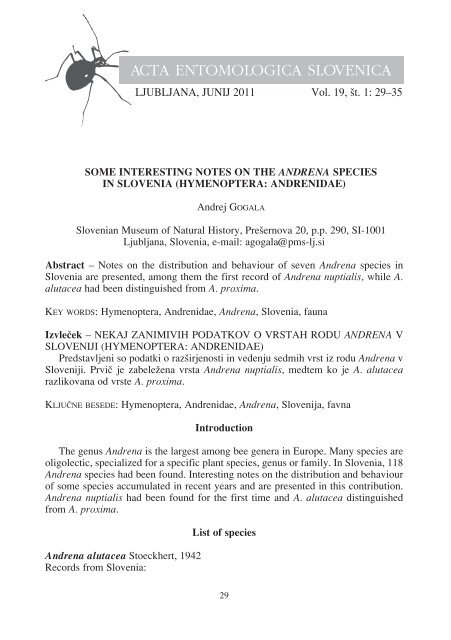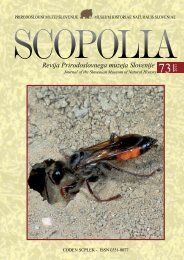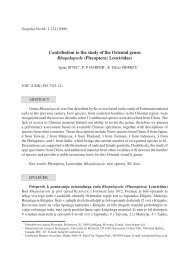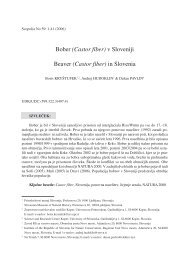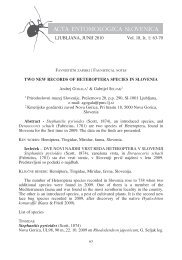Create successful ePaper yourself
Turn your PDF publications into a flip-book with our unique Google optimized e-Paper software.
<strong>ACTA</strong> <strong>ENTOMOLOGICA</strong> <strong>SLOVENICA</strong><br />
LJUBLJANA, JUNIJ 2011 Vol. 19, øt. 1: 29–35<br />
SOME INTERESTING NOTES ON THE ANDRENA SPECIES<br />
IN SLOVENIA (HYMENOPTERA: ANDRENIDAE)<br />
Andrej GOGALA<br />
Slovenian Museum of Natural History, Preøernova 20, p.p. 290, SI-1001<br />
Ljubljana, Slovenia, e-mail: agogala@pms-lj.si<br />
Abstract – Notes on the distribution and behaviour of seven Andrena species in<br />
Slovenia are presented, among them the first record of Andrena nuptialis, while A.<br />
alutacea had been distinguished from A. proxima.<br />
KEY WORDS: Hymenoptera, Andrenidae, Andrena, Slovenia, fauna<br />
Izvleœek – NEKAJ ZANIMIVIH PODATKOV O VRSTAH RODU ANDRENA V<br />
SLOVENIJI (HYMENOPTERA: ANDRENIDAE)<br />
Predstavljeni so podatki o razøirjenosti in vedenju sedmih vrst iz rodu Andrena v<br />
Sloveniji. Prviœ je zabeleæena vrsta Andrena nuptialis, medtem ko je A. alutacea<br />
razlikovana od vrste A. proxima.<br />
KLJUŒNE BESEDE: Hymenoptera, Andrenidae, Andrena, Slovenija, favna<br />
Introduction<br />
The genus Andrena is the largest among bee genera in Europe. Many species are<br />
oligolectic, specialized for a specific plant species, genus or family. In Slovenia, 118<br />
Andrena species had been found. Interesting notes on the distribution and behaviour<br />
of some species accumulated in recent years and are presented in this contribution.<br />
Andrena nuptialis had been found for the first time and A. alutacea distinguished<br />
from A. proxima.<br />
Andrena alutacea Stoeckhert, 1942<br />
Records from Slovenia:<br />
List of species<br />
29
Acta entomologica slovenica, 19 (1), 2011<br />
Log, Lukovica, VL59, 6. 7. 1991, 1≈, A. Gogala leg.<br />
Brezovica pri Lj., VL59, 29. 7. 1991, 1≈, A. Gogala leg.<br />
Rakitna, VL58, 11. 6. 1993, 1≈, A. Gogala leg.<br />
Nanos: Sv. Hieronim – Pleøa, VL27, 4. 7. 1998, 1≈, A. Gogala leg.<br />
Œaven: planinska koœa, VL18, 7. 7. 2007 on Laserpitium siler, 1≈, A. Gogala leg.<br />
Kranj, Brdo, VM52, 14. 6. 2007, 1≈, A. Gogala leg.<br />
I treated A. alutacea as a synonym of Andrena proxima (Kirby) in the Checklist of<br />
the bee fauna of Slovenia (Gogala 1999). Schmid-Egger (2005) published a revision<br />
in which he treats it as a distinct species. Apart from the morphological differences,<br />
A. alutacea is active later in the season than A. proxima. In Slovenia, proved specimens<br />
of A. proxima were collected from the April 14th to May 8th (males and females),<br />
and females of A. alutacea from June 11th to July 29th (males were not found<br />
yet).<br />
Andrena chrysopus Pérez, 1903<br />
Records from Slovenia:<br />
Kras: Tublje pri Komnu, VL07, 10. 5. 2003 on Asparagus officinalis, 1≈, A. Gogala leg.<br />
Lukovec, Rabotnica, VL07, 10. 5. 2009 on Asparagus officinalis, 1≈, photo A.<br />
Gogala<br />
In the first record of this oligolectic species for Slovenia (Gogala 2004) I stated that<br />
it was observed and collected on Asparagus tenuifolius. That’s wrong. I didn’t know<br />
at the time that Asparagus officinalis also grows in the wild in the Kras plateau and<br />
looks similar. Later I found and photographed A. chrysopus on the Rabotnica hill<br />
near Lukovec, again on A. officinalis (Fig. 1). I never found it on A. tenuifolius,<br />
which blooms approximately at the same time. On that Asparagus species Andrena<br />
fulvata Stoeckhert, a polilectic species, was found to collect several times. I conclude<br />
that Andrena chrysopus is monolectic in Slovenia (collects pollen of a single plant<br />
species).<br />
Andrena lapponica Zetterstedt, 1838<br />
Records from Slovenia:<br />
Dragomer, VL59, 14. 4. 1992, 1≈, A. Gogala leg., 29. 3. 1997, 1≈, A. Gogala leg.<br />
Dragomer, Debeli hrib, VL59, 25. 4. 2004 on Vaccinium myrtillus, 1≈, photo A.<br />
Gogala<br />
Log, Lukovica, VL59, 6. 4. 1993, 1Δ, A. Gogala leg.<br />
Œrni Vrh, Pasja ravan, VM40, 30. 3. 1994, 1Δ, A. Gogala leg.<br />
Kamniøka Bistrica, VM63, 31. 3. 1994, 2Δ, A. Gogala leg., 1≈, A. Gogala vid.<br />
Smrekovec, 1520 m, VM94, 2. 6. 1999 on Vaccinium myrtillus, 1≈1Δ, A. Gogala leg.<br />
Sneænik, 1600 m, VL54, 3. 6. 2000, 1≈, A. Gogala leg., 1700 m, 25. 6. 2008 on<br />
Salix, 1≈, A. Gogala leg., 1780 m, 30. 6. 2010 on Helianthemum, 1≈, photo A.<br />
Gogala<br />
A. lapponica is known as an oligolectic species, collecting from Vaccinium species<br />
(Ericaceae) in most of its range. Vaccinium myrtillus is its host plant in Alpine and<br />
pre-Alpine regions of Slovenia. But this bee is present also on Mt. Sneænik, the high-<br />
30
A. Gogala; Some interesting notes on the Andrena species in Slovenia (Hymenoptera: Andrenidae)<br />
est Dinaric mountain in Slovenia. The limestone ground there is not suitable for<br />
Vaccinium myrtillus, which grows in acidic substrate only. A. lapponica is a common<br />
species there up to the top of the mountain at 1796 m. In contrast to its behaviour<br />
elsewhere it collects pollen from Salix and Heliathemum flowers (Fig. 2) in this<br />
locality. Obviously, this population at the southern limit of distribution is polilectic<br />
(A. lapponica is a boreo-montane species). The population on Mt. Sneænik is probably<br />
a relic from the ice-age. Both host plants are visited, however, also in the<br />
Austrian Alps and pollen collected at least from Helianthemum also there (Ebmer<br />
2003). Therefore, A. lapponica is not so strict an oligolege that it could not adapt to<br />
local circumstances.<br />
Andrena nuptialis Pérez, 1902<br />
New to Slovenia:<br />
Istra: Rakitovec, Kavœiœ, 780 m, VL23, 29. 7. 2009 on Eryngium amethystinum, 1≈,<br />
A. Gogala leg.<br />
North Mediterranean species, bivoltine. While spring generation is polilectic, the oligolectic<br />
summer generation collects from Apiaceae only. Summer generation could<br />
possibly be a distinct species (Westrich 1990). At the end of July 2009 I visited Mt.<br />
Kavœiœ in Œiœarija, Slovene Istria, again. At the place where I found specimens of<br />
Melitta tomentosa Friese and Hoplitis mazzuccoi (Schwarz & Gusenleitner) for the<br />
first time before (Gogala 2009a, b), several females of Andrena nuptialis collected<br />
pollen or nectar from Eryngium amethystinum inflorescences (Fig. 3). Although the<br />
host plant is very numerous in the whole Kras plateau, A. nuptialis had never been<br />
found before in Slovenia.<br />
Andrena pellucens Pérez, 1895<br />
Records from Slovenia:<br />
Podœetrtek, WM41, 28. 8. 1937, 1≈, E. Jaeger leg.<br />
Brje pri Komnu, VL07, 29. 9. 1990, 1≈, A. Gogala leg., 7. 9. 1996, 2≈, A. Gogala<br />
leg., 13. 9. 1992, 1Δ, A. Gogala leg.<br />
Komen, Økrbina, VL07, 7. 9. 2008 on Crepis, 1≈, A. Gogala leg.<br />
Preserje pod Krimom, Ponikve, VL58, 12. 9. 2008, 1≈, A. Gogala leg., 15. 9. 2008,<br />
1Δ, photo A. Gogala, 8. 10. 2008, 2≈, A. Gogala vid.<br />
A. pellucens is known to collect pollen of Colchicum, Smilax and related plants in the<br />
Liliaceae and Iridaceae families (K. & L. Standfuss 2010, Scheuchl pers. comm.). In<br />
the Kras plateau in Slovenia, however, I observed it many times on yellow<br />
Asteraceae Cichorioideae, as Leontodon and Crepis species (Fig. 4). Analysis of<br />
pollen loads were not made, but females were collecting pollen almost certainly. It<br />
is a question whether species is polilectic or oligolectic, but adaptable.<br />
In September 2008 I found the species in Central Slovenia for the first time. A<br />
numerous nest aggregation was situated in a cart track crossing a meadow on a sunny<br />
slope near Preserje pod Krimom (Dinaric region). During cloudy weather females<br />
and males rested on Cichorium and Leontodon flowers. Females were still active in<br />
31
Acta entomologica slovenica, 19 (1), 2011<br />
October, when very few bee species could be seen. It is thus one of the last Andrena<br />
species in the season.<br />
Andrena rogenhoferi Morawitz, 1872<br />
Records from Slovenia:<br />
Ebmer, 1997: Karavanke, Koøutnikov turn, 1700 m, 22. 7. 1996, 1≈<br />
Triglav: Mali Triglav, 2700 m, VM13, 7. 8. 1991 on Potentilla nitida, 1≈, A. Gogala leg.<br />
Bohinj: Ukanc, VM02, 24. 4. 1994 on Salix, 2Δ, A. Gogala leg.<br />
Sneænik, 1600 m, VL54, 28. 6. 2008 on Rosa, 1≈, photo A. Gogala, 1700 m, 30. 6.<br />
2010 on Salix, 1≈, photo A. Gogala<br />
Sneænik, 1780 m, VL54, 3. 6. 2000, 1≈, A. Gogala vid.<br />
Œaven: Kucelj, VL08, 10. 7. 2010 on Laserpitium siler, 1≈, A. Gogala vid.<br />
A. rogenhoferi is an Alpine species. According to Zettel et al. (2008) it is distributed<br />
in the whole Alpine arch with only one record outside it: Jura Mts. in Switzerland.<br />
In the south-east it should be distributed to the Karavanke Mts. at the northern border<br />
of Slovenia, although the authors cite also my record from Mt. Triglav (Julian<br />
Alps). The highest locality where I found the species in Slovenia is at 2700 m (Mali<br />
Triglav) and the lowest point in Ukanc in the Bohinj valley at 530 m a.s.l. where<br />
males were found. In recent years I found this species also on Mt. Sneænik, the highest<br />
Dinaric mountain in Slovenia. That is the first record of the species in the Balkan<br />
mountain ranges and expands considerably its known distribution to the south. In<br />
2010 I’ve seen one specimen also on Mt. Œaven, a locality in-between the Dinaric<br />
and Alpine records of the species. On Mt. Sneænik A. rogenhoferi can be seen above<br />
the forest limit from 1600 m a.s.l. to the top of the mountain at 1796 m. I documented<br />
it collecting pollen from Rosa (Fig. 5) and Salix flowers. It is a polilectic species.<br />
It is interesting that the German name of Mt. Sneænik, used in the time of Austro-<br />
Hungarian empire, is Schneeberg (translation of the Slovene name). That is also the<br />
name of one of the localities, where syntypes of A. rogenhoferi were collected, but<br />
that Schneeberg mountain is situated near Wien in Austria (Zettel et al. 2008).<br />
Andrena susterai Alfken, 1914<br />
Records from Slovenia:<br />
Kras: Kregoliøœe, VL07, 16. 5. 1992 on Cotinus coggygria, 1≈, A. Gogala leg.<br />
Kraøki rob: Podpeœ, VL14, 23. 5. 1995, 1≈, A. Gogala leg.<br />
Soœerga, Veli Badin, VL13, 2. 5. 2009 on Cotinus coggygria, 1≈, A. Gogala leg.<br />
Obreæ, Grabe, WM94, 29. 6. 1995, 1Δ, A. Gogala leg.<br />
A. susterai is a species with a pontic distribution which reaches its western limit in<br />
the Kras plateau in Slovenia. It is a polilectic species (Schmid-Egger & Scheuchl<br />
1997), but in the Kras I observed it only on the flowers of Cotinus coggygria (Fig.<br />
6). This is a rich source of nectar, so it attracts many bees and other insects, but no<br />
specialized oligolectic bees are known to collect only its pollen. Examinations of the<br />
pollen loads of A. susterai females are needed before we make conclusions about its<br />
food preferences.<br />
32
A. Gogala; Some interesting notes on the Andrena species in Slovenia (Hymenoptera: Andrenidae)<br />
Fig. 1: Andrena chrysopus on Asparagus officinalis. Rabotnica, May 2009.<br />
Fig. 2: Andrena lapponica on Helianthemum. Sneænik, 1780 m, June 2010.<br />
Fig. 3: Andrena nuptialis on Eryngium amethystinum. Kavœiœ, July 2009.<br />
Fig. 4: Andrena pellucens on Crepis. Økrbina, September 2008.<br />
Discussion<br />
With two additional species (Andrena alutacea and A. nuptialis) the number of<br />
recorded bee species in Slovenia rose to 558. Lasioglossum aeratum (Kirby) is not<br />
included in that number although listed by Gogala (1999), because the records of this<br />
species are not proved yet. Included are, however, species of bumblebees and a<br />
Ceratina species recorded by Barbattini et al. (2007) on the basis of old specimens<br />
in the Trieste Museum: Ceratina callosa found in Lipica by Gräffe, Bombus ruderatus,<br />
found in Pivka in 1915, B. pomorum, found in Postojna (1927), and B. maxillosus<br />
(from Rodik, Lipica and Nanos). Andrena parviceps Kriechbaumer, 1873, is<br />
also missing in the Checklist, although var. basalis was described on a specimen<br />
from Lipica (Kriechbaumer 1873).<br />
33
Acta entomologica slovenica, 19 (1), 2011<br />
Fig. 5: Andrena rogenhoferi on Rosa. Sneænik, 1600 m, June 2008.<br />
Fig. 6: Andrena susterai on Cotinus coggygria. Veli Badin, May 2009.<br />
Fig. 7: The distribution of Andrena rogenhoferi in Slovenia.<br />
Fig. 8: The distribution of Andrena susterai in Slovenia.<br />
References<br />
Barbattini, R., F. Frilli, P. Zandigiacomo, G. Pagliano, M. Quaranta, 2007:<br />
Apoidea del Friuli Venezia Giulia e di territori confinanti. II: Apidae.<br />
Gortania, 28: 139-184.<br />
Ebmer, A.W., 1997: Hymenopterologische Notizen aus Österreich - 7. Linzer biol.<br />
Beitr., 29: 45-62.<br />
Ebmer, A.W., 2003: Hymenopterologische Notizen aus Österreich – 16 (Insecta:<br />
Hymenoptera: Apoidea). Linzer biol. Beitr., 35 (1): 313-403.<br />
Gogala, A., 1999: Bee Fauna of Slovenia: Checklist of Species (Hymenoptera:<br />
Apoidea). Scopolia, 42: 1-79.<br />
Gogala, A., 2004: First record of Andrena chrysopus Pérez in Slovenia<br />
(Hymenoptera: Andrenidae). Acta entomologica slovenica, 12: 168.<br />
34
A. Gogala; Some interesting notes on the Andrena species in Slovenia (Hymenoptera: Andrenidae)<br />
Gogala A., 2009a: Mediterranean bee species, newly recorded in Slovenia<br />
(Hymenoptera: Apoidea). Acta entomologica slovenica, 17 (1): 73-78.<br />
Gogala A., 2009b: Hoplitis mazzuccoi (Schwarz & Gusenleitner) in Slovenia and<br />
Micreriades species of the East Adriatic coast (Hymenoptera: Megachilidae).<br />
Acta entomologica slovenica, 17 (2): 93-98.<br />
Kriechbaumer, J., 1873: Hymenopterologische Beiträge III. Verh. Zool.-bot. Ges.<br />
Wien, 23: 49-68.<br />
Schmid-Egger, C., 2005: Proxiandrena subgen. nov. und Revision der west- und<br />
zentralpaläarktischen Arten der Andrena proxima-Gruppe (Hymenoptera,<br />
Apidae). Revue Suisse de Zoologie, 112 (4): 1029-1044.<br />
Schmid-Egger, C., E. Scheuchl, 1997: Illustrierte Bestimmungstabellen der<br />
Wildbienen Deutschlands und Österreichs, Band III: Andrenidae. Eigenverlag,<br />
Velden/Vils, 180 pp.<br />
Standfuss, K., L. Standfuss, 2010: Andrena pellucens Pérez, 1895 und Nomada<br />
argentata Herrich-Schäffer, 1839 in Griechenland. Bembix, 30: 35-40.<br />
Westrich, P., 1990: Die Wildbienen Baden-Württembergs, 2. verb. Aufl., Ulmer,<br />
Stuttgart.<br />
Zettel, H., A.W. Ebmer, H. Wiesbauer, 2008: Zur Kenntnis der Wildbienen<br />
(Hymenoptera: Apidae) in Wien, Niederösterreich und dem Burgenland<br />
(Österreich) – 4. Beiträge zur Entomofaunistik, 9: 13-30.<br />
Received / Prejeto: 9. 2. 2011<br />
35
Acta entomologica slovenica, 19 (1), 2011<br />
3. SLOVENSKI ENTOMOLOØKI SIMPOZIJ<br />
Z MEDNARODNO UDELEÆBO<br />
Biologi z Oddelka za biologijo – sodelavci obeh zooloøkih kateder<br />
(Katedre za zoofiziologijo in etologijo, Katedre za zoologijo) bomo<br />
skupaj s Slovenskim entomoloøkim druøtvom Øtefana Michielija<br />
organizirali 3. slovenski entomoloøki simpozij z mednarodno udeleæbo.<br />
Simpozij bo potekal 27. in 28. januarja 2012 v Mariboru.<br />
Veœ podatkov najdete na spletnem naslovu http://3ses.fnm.uni-mb.si.<br />
•<br />
THIRD SLOVENIAN <strong>ENTOMOLOGICA</strong>L SYMPOSIUM<br />
WITH INTERNATIONAL ATTENDANCE<br />
Biologists from the Department of Biology (Section for Animal<br />
Physiology and Ethology, Section for Zoology) and the Slovenian<br />
Entomological Society »Øtefan Michieli« will organize the 3rd Slovenian<br />
Entomological Symposium with International Attendance. The<br />
Symposium will be held from 27 to 28th January 2012 in Maribor.<br />
First Circular and Registration Form are available at URL<br />
http://3ses.fnm.uni-mb.si.<br />
Za organizatorje / For organizers<br />
V. Klokoœovnik, S. Lipovøek in D. Devetak<br />
36


